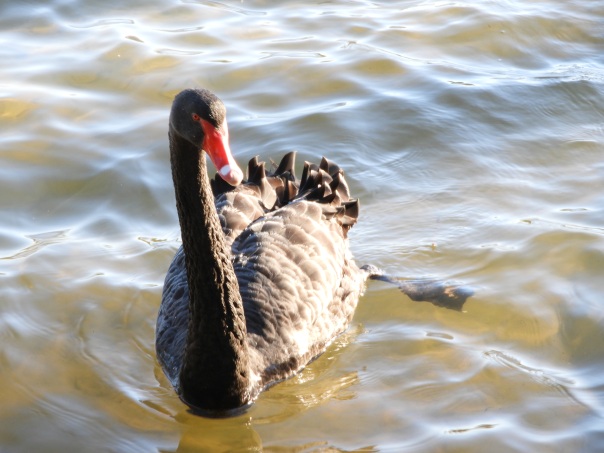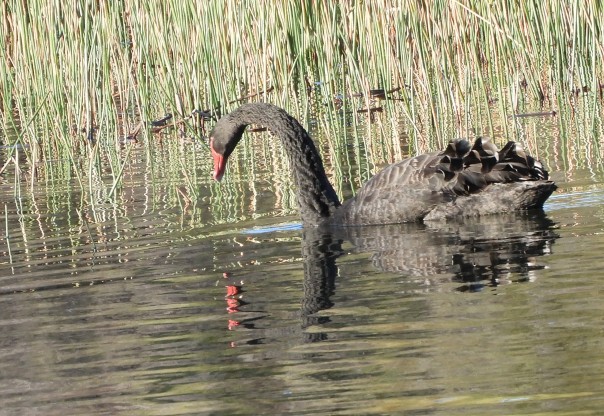Category Archives: Swan
Lone cygnet for this Black Swan couple
A pair of Black Swans in my neighbourhood has a single cygnet this year. Baby black swans are so cute! An adorable bundle of grey-cream fluff with black beaks, eyes, and legs:
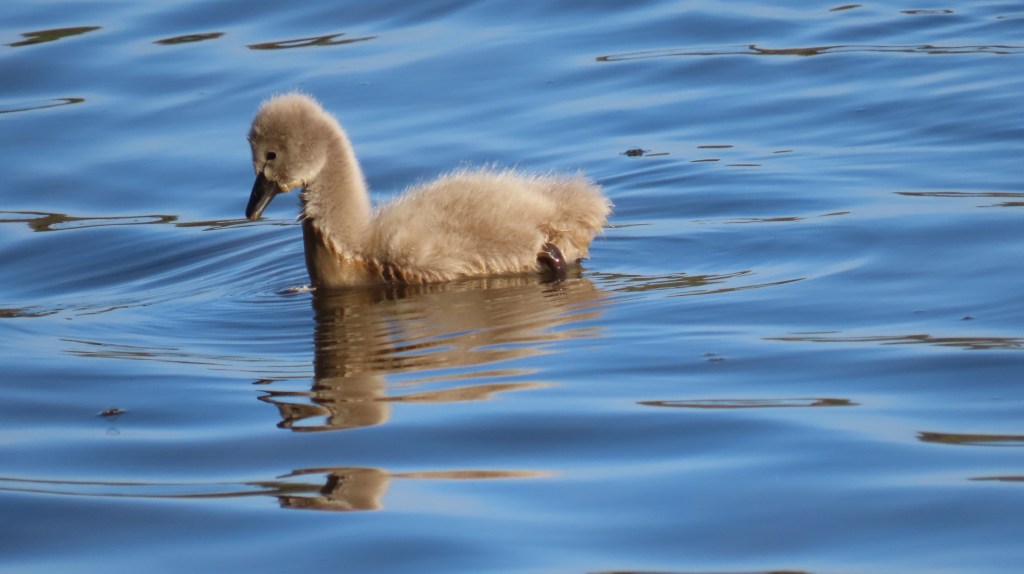
I don’t know how many eggs there were in the brood, nor how many of them hatched. Alas, baby swans are prey to several natural predators, especially hawks and eagles, as well as to introduced animals like dogs, cats, and foxes.
Here’s the baby and one of the adults, in a lovely mellow lighting:

It’s good to see any young swans at all — I didn’t spot any last year. In fact, I watched a pair of swans devotedly tend their nest for eight months without hatching any eggs! It’s possible they were both males, practising their nesting skills together in the absence of any females. I wrote about their vigil in two posts: part 1 and part 2.
So it’s great to see these two adults looking after the little one:
Common name: Black Swan
Scientific name: Cygnus atratus
Approximate length of adult bird: 120 cm
Date spotted: 25 November 2025 (spring)
Approximate location: Sydney’s Northern Beaches, New South Wales, Australia
Longest nest-sitting ever: Black Swans abandon nest after 8 months (part 2 of story)
Over the past 8 months, two Black Swans have been diligently tending a nest in Manly Dam Park, in Sydney’s Northern Beaches. In the early days (August 2024), spring was in the air. Nature was blooming and the swans were devoted and diligent. As spring turned to summer, the heat bore down. Cicadas shrieked, reeds grew up and died down again. Still, the pair tended the nest, rebuilding regularly, looking after each other, and clearing the water around their nest. (Story of two nesting Black Swans: Part 1)
Yesterday (9 April 2025), for the first time, the nest was empty when I walked past. The nest is the large circle of brown reeds lying horizontal behind the green reeds:

A hundred metres away, one of the swans was drifting on the water, hooting quietly and persistently:
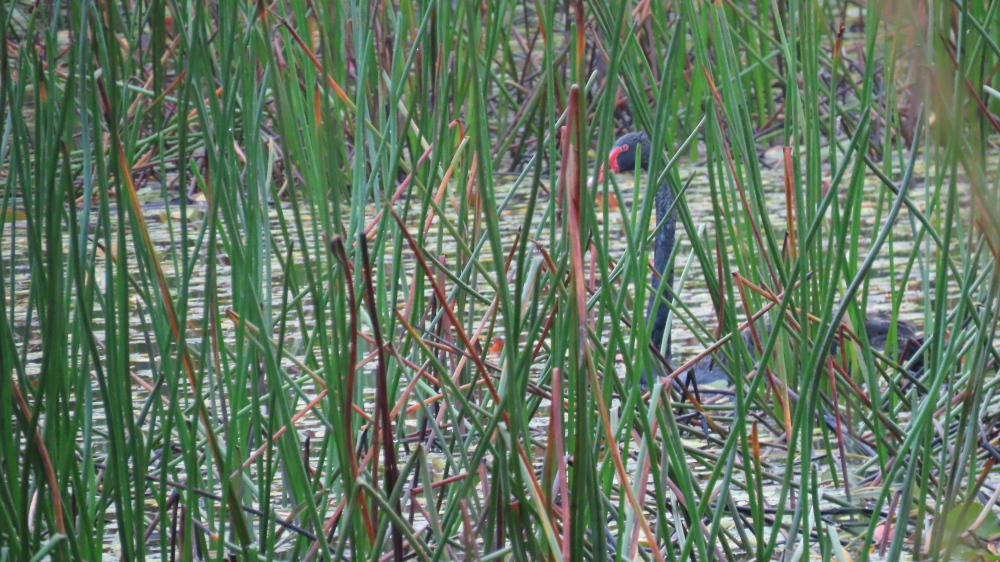
Once or twice I heard the other swan replying from deep in the reeds, but I didn’t see it.
At my previous visit a week ago, the swans had moved their nest to a slightly different location, just ten metres or so away from the original location. I wondered if this meant that at last, there was hope for an egg or two. Who knows, perhaps the pair will proudly emerge with a train of cygnets to show. Alas, though, I doubt that there were ever any eggs in the nest. From a discussion on Reddit, it seems that the most likely explanation is that the swans are two males, practising nest-building and nest-sitting in the absence of a female to lay an egg.
Here’s a photo from October 2024, showing both swans at the nest:

Here’s one of the swans in early February 2025, off shift for a moment while its partner sits on the nest:
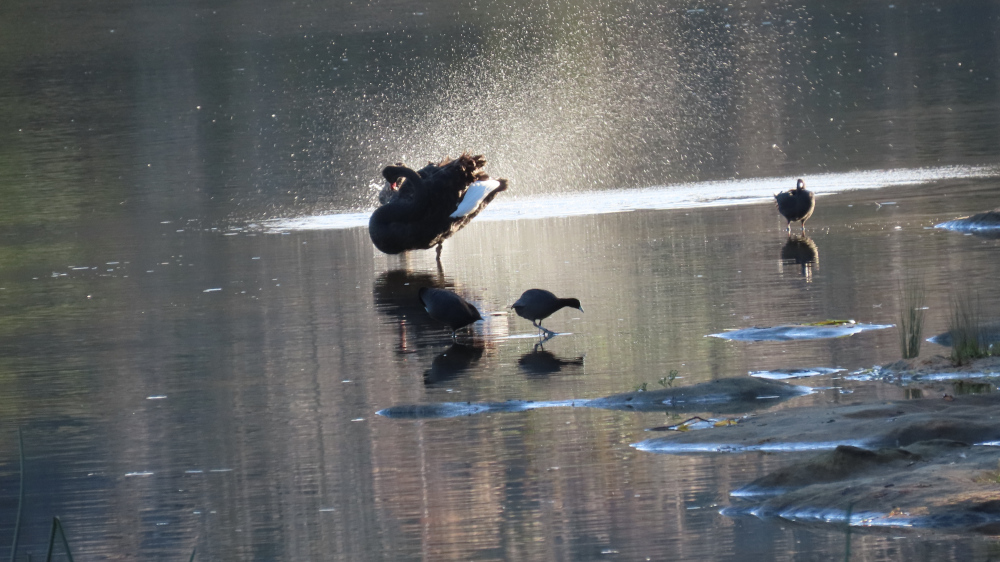
This is the tranquil site of the nest, now empty, but ready perhaps for a new attempt come spring:
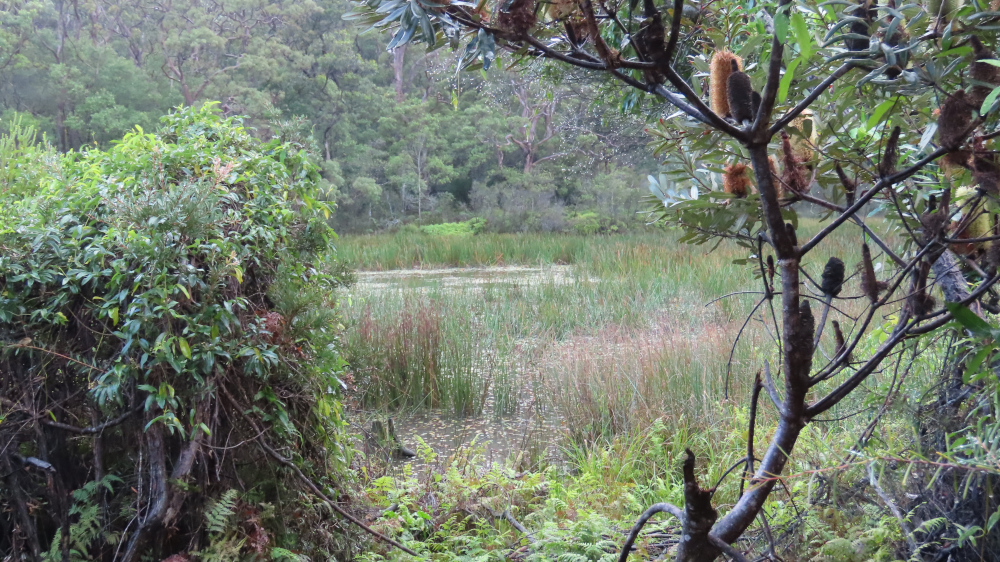
Common name: Black Swan
Scientific name: Cygnus atratus
Approximate length: 120 cm
Date spotted: 23 August through to 9 April 2025 (late winter, through spring and summer, into autumn)
Approximate location: Manly Dam Park, New South Wales, Australia
Story of two nesting Black Swans: Part 1
This is part 1 of a story about a pair of nesting Black Swans. At this point, I’m concerned about the state of the swans’ eggs. I don’t know what part 2 will hold, but I do hope for a happy ending.
These two swans have been sitting on their nest since late August. I first saw them sitting on 23 August, and a park ranger told me that they’d been sitting for at least a few days by then. It’s now 9 December. That’s more than 15 weeks — more than 105 days.
The eggs of Black Swans usually hatch after 39-45 days.
This photo is from the first time that I saw the nest, on 23 August:
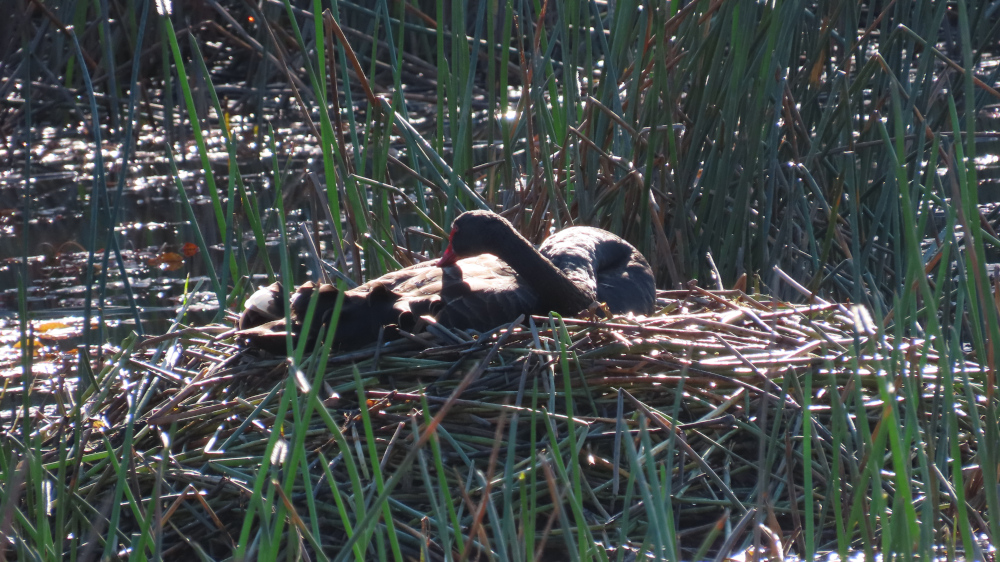
(Photo taken on 23 August 2024)
The swan’s nest is a large pile of reeds, positioned in shallow water in the middle of a large reed bed. It’s quite a distance from the shore on both sides, and well screened from entrance on the water too. From the shore, it’s not possible to see into the nest. I’m assuming there are eggs, because the swans are very diligent about sitting on the nest and occasionally it looks as if they gently prod the eggs with their beaks.
Here’s another photo from the early days:
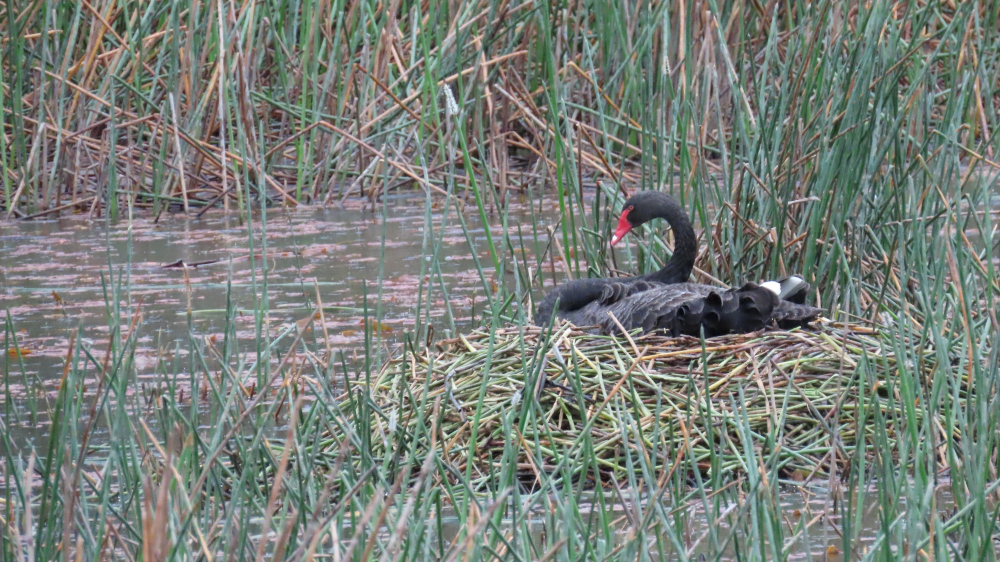
(Photo taken on 24 August 2024)
The setting is tranquil and pretty:
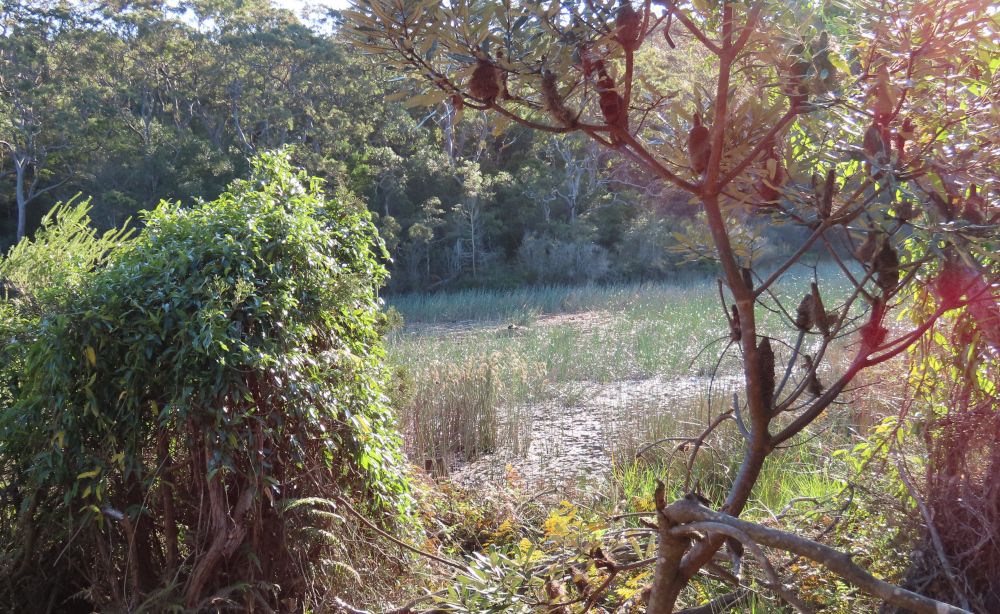
(Photo taken on 2 September 2024)
The nest is near a popular bush walking path, and I’ve walked past it every few days. When the first period of 45 days went by with no cygnets appearing, I thought maybe the parents had decided that their first batch of eggs was infertile and had started again.
But now the second period of 45 days is well and truly passed, and I’m worried.
Both the male and the female swan are still actively looking after the nest. I’ve seen each of them sitting on the nest alone, and occasionally both of them tending the nest together. The nest is never without one of the swans sitting or standing over it.

(Photo taken on 3 October 2024)
The male and female take turns to sit on the nest. The next video shows the changing of the guard. One bird has been sitting all night, the other has arrived for the morning shift. One of the birds grooms itself, and they both do a bit of nest maintenance. If you listen carefully, you can hear the swans’ soft hoots as they chat to each other:
(Video taken on 1 October 2024)
Every now and then, the swans spend quite some time and energy clearing the reeds around the nest and building up the nest:

(Photo taken on 3 October 2024)
Despite the nest’s seclusion, plenty of ducks, coots, and moorhens swim around the nest, keeping the swans company. Every now and then other visitors appear, like this kookaburra:

(Photo taken on 4 October 2024)
And this Eastern Water Dragon:

(Photo taken on 17 November 2024)
On 1 October, a beautiful light-coloured Grey Goshawk made an appearance near the nest, and was chased away by currawongs and cockatoos:

(Photo taken on 1 October 2024. I wrote another post about the goshawk.)
Here’s a nice video of one of the swans seating itself carefully on the nest:
(Video taken on 28 October 2024)
In more recent days, the site of the nest has become less tranquil. Cicadas have crept up from the earth to celebrate the summer full blast, as only cicadas can do. Sulphur-crested Cockatoos collect in the tree tops, high above the nest. The cockatoos squawk and yell, outdoing even the cicadas. It’s a very noisy environment for a nest, but at least it gives the parent swans some company. At this stage, they’d been sitting on the nest for more than 100 days:
(Video taken on 29 November 2024)
When it’s their turn for a break from sitting on the nest, one of the adults heads off to another part of the dam to stretch and feed. Here, a pelican keeps the off-duty swan company:
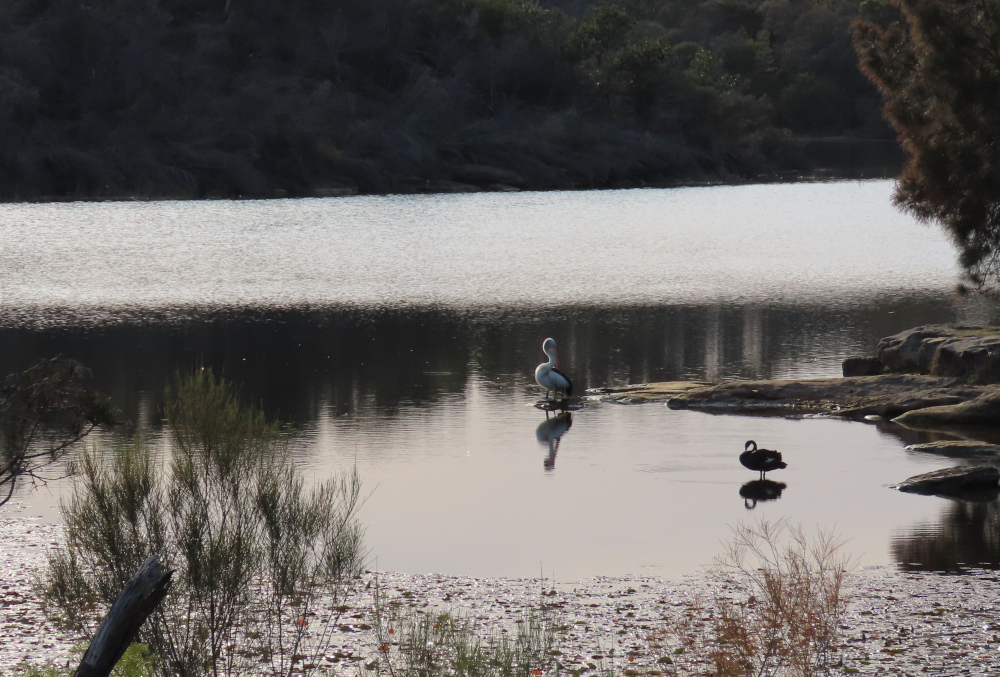
(Photo taken on 9 September 2024)
It’s good to stretch and preen:
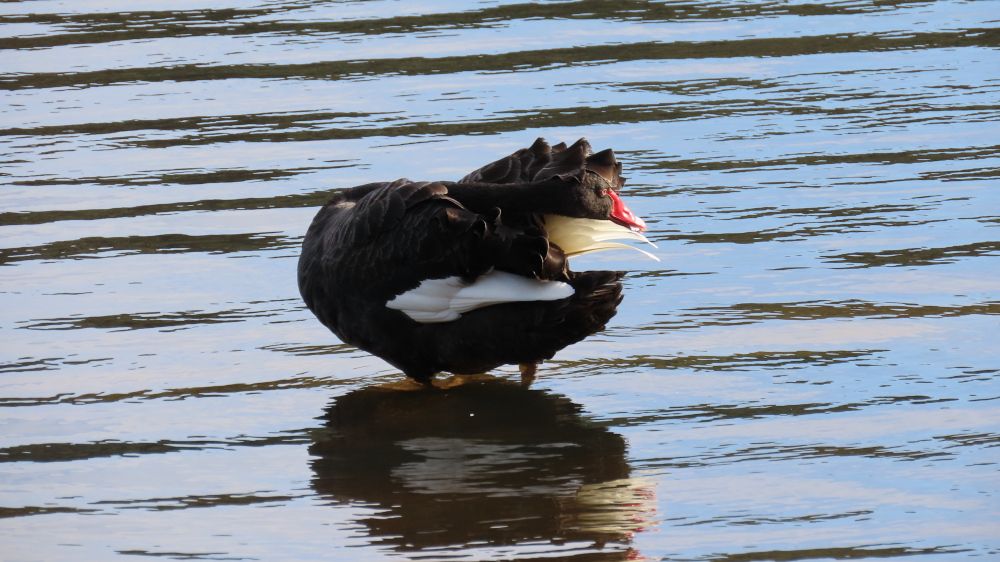
(Photo taken on 9 September 2024)
In the next video, one of the swans comes in close to shore for a good stretch. Eastern Koel cuckoos and cicadas dominate the sound waves. On a rock nearby, an Eastern Water Dragon looks on:
(Video taken on 21 November 2024)
In the next video, a Great Cormorant watches on as the swan preens and fluffs its wings. Cockatoos, Eastern Koels, and Channel-billed cuckoos call in the distance:
(Video taken on 29 November 2024)
As I write this post, December has arrived and the bush has a surfeit of insects. It’s very noisy at the swans’ nest. Two kookaburras dropped by and chatted a bit. Moths flap past, cicadas shriek, and a dead heat beats down on the nest:
(Video taken on 6 December 2024)
The last time I visited the nest was yesterday, 8 December. The swans were still sitting. Two kookaburras dropped by again and the cicadas were still very noisy.
I’ll keep a look out to see what’s happening at the nest next time I pass. I do hope to see the two swans relieved of their nesting duties. It would be wonderful to see some little ones to reward their amazing dedication. Even if there are no cygnets, though, it’d be good to see the adults roaming free again, ready for another go at raising a family next year.

(Photo taken on 8 December 2024)
Good luck, patient swans!
Update on 10 April 2025: Black Swans abandon nest after 8 months (part 2 of story).
Common name: Black Swan
Scientific name: Cygnus atratus
Approximate length: 120 cm
Date spotted: 23 August through to 8 December, 2024 (late winter, through spring, going into early summer)
Approximate location: Manly Dam Park, New South Wales, Australia
Black swans asleep on one leg
In the early morning sunshine, two black swans sleep. Both swans sleep with one leg raised, one leg holding the bird up, and head tucked under a wing. This swan has a watchful eye open:
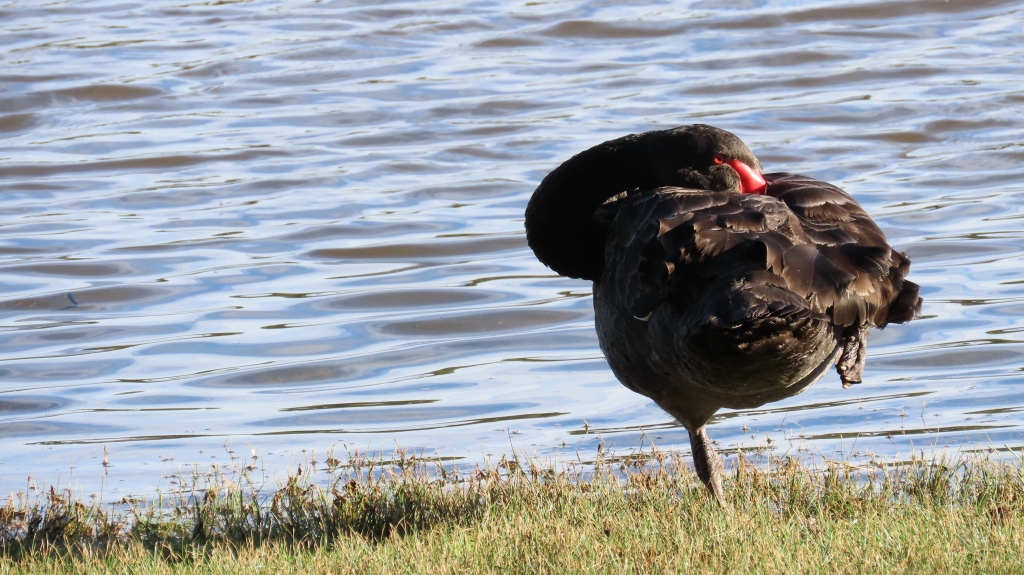
The other swan’s eyes are closed. Its foot is tucked close to its body:
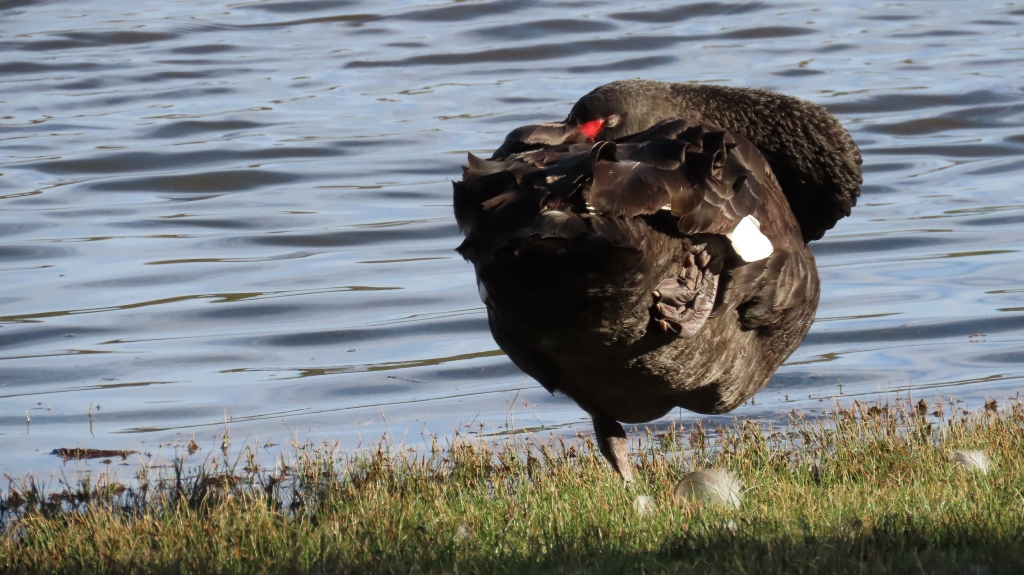
When I pass the same spot a few days later, a swan drifts peacefully on the water:

Black Swans are native to Australia, and are common around Sydney.
Common name: Black Swan
Scientific name: Cygnus atratus
Approximate length: 120 cm
Date spotted: 8th and 17th April 2024 (autumn)
Location: Manly Dam Park, New South Wales, Australia: 33°46’35.4″S 151°14’49.8″E
Black Swan grooming
Early in the morning, a Black Swan was grooming.
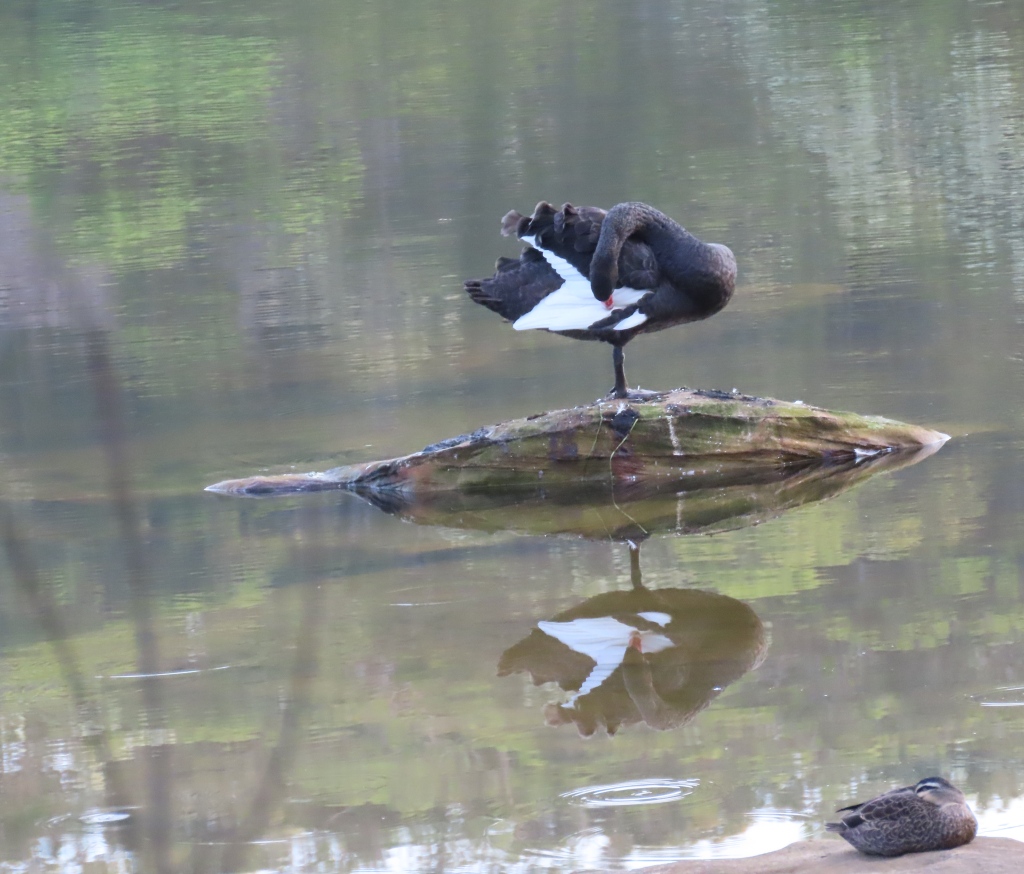
In the foreground, a Pacific Black Duck still sleeps.

Common name: Black Swan
Scientific name: Cygnus atratus
Approximate length: 120 cm
Date spotted: 4 February 2024 (summer)
Location: Manly Dam Park, New South Wales, Australia: 33°46’35.4″S 151°14’49.8″E
Swans enjoying flooded picnic area
It’s been a bit wet on the east coast of Australia. For many people, the recent floods have been devastating and very sad. I’ve been lucky to be largely unaffected. I’m so sorry for all those who’re still suffering the effects of the flood
Yesterday it stopped raining and I went for a walk. I came across these swans exploring a picnic area:
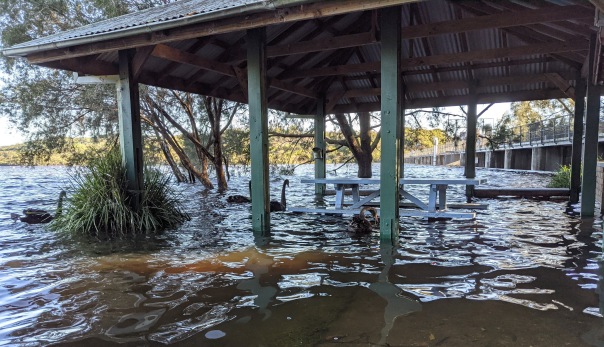
Today the water has already receded quite a bit:
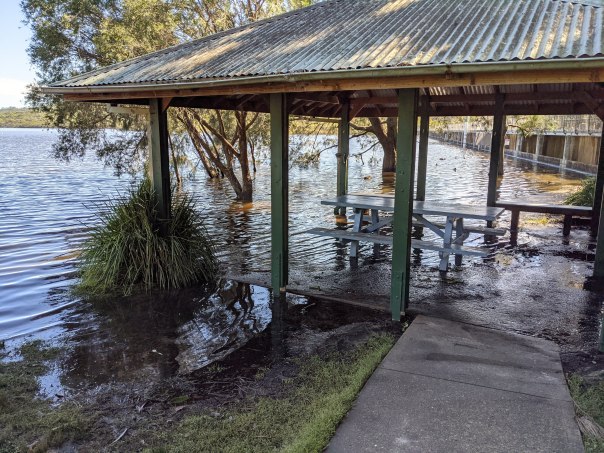
The swans are nearby, relaxing on the recently-emerged grass:

For those who’ve seen my posts about the family of swans over the past few months: yes, this is the same family. The babies are pretty much grown up already.
Common name: Black Swan
Scientific name: Cygnus atratus
Approximate length: 120 cm
Date spotted: 25 March 2021 (autumn)
Location: Manly Dam Park, New South Wales, Australia: 33°46’58.5″S 151°15’18.6″E
Eat your greens! Baby swans growing up
Early in October I spotted a family of swans at Manly Dam. These are Australian Black Swans. When I first saw them, there were five baby swans (cygnets), closely watched over by two adults. This was one of the little ones, just a few days old then, I think:

Since then, I’ve been watching the cygnets grow. Alas, two of them disappeared over the weeks. But there are still three of the cygnets, still with their parents in late December, and much bigger and stronger.
The video below shows a cygnet and a parent feeding on water weeds. This was towards the end of November, when the cygnets were around six weeks old. Near the beginning of the video, the adult swan grabs a clump of weed and dumps it near the baby.
Eat your greens!
Later the video zooms out to show the entire family of three babies and two adults:
Here’s one of the cygnets swimming with an adult, also at around six weeks old:

On 23 December, at ten to eleven weeks old, the cygnets are much bulkier and their faces look more swan-like:

Even at this age, their wings are still small and stumpy, nowhere near ready for flight:
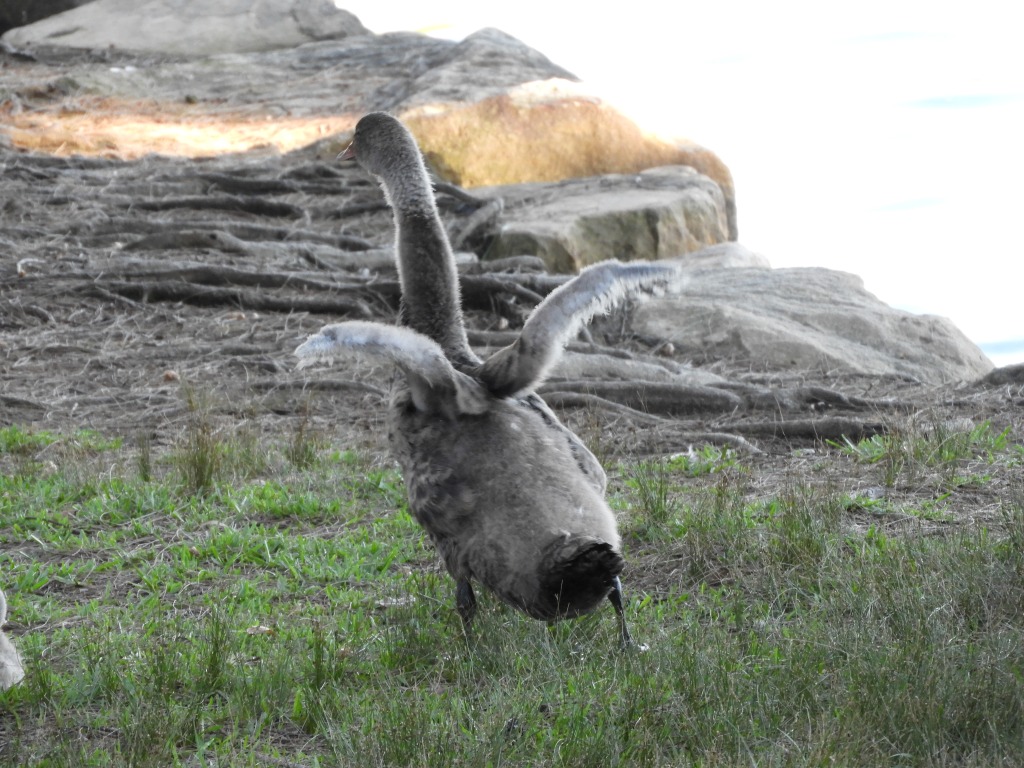
Common name: Black Swan
Scientific name: Cygnus atratus
Approximate length of adult: 120 cm
Date spotted: 9 October 2020 (spring) through to 23 December 2020 (summer)
Location: Manly Dam Park, New South Wales, Australia: 33°46’58.5″S 151°15’18.6″E
Baby black swans and ducklings
Baby swans are called cygnets. Pictures of cygnets from white swans are quite common, but what do baby black swans look like? Very similar to the white-swan babies, it turns out. They’re grey and fluffy, with black eyes, feet, and beak. I was delighted to spot a family of black swans while out walking a couple of days ago.

The parent swans were watchful, taking care to keep their little ones in a group. A male swan is called a cob, and a female is a pen. Five babies! That’s a lot of curiosity and cuteness to look after.

Did I say five babies? Yes. One of the cygnets was fossicking around in the undergrowth at the water’s edge. You can see the fifth little one in this video:
Common name: Black Swan
Scientific name: Cygnus atratus
Approximate length of adult: 120 cm
Date spotted: 9 October 2020 (spring)
Location: Manly Dam Park, New South Wales, Australia: 33°46’58.5″S 151°15’18.6″E
Nearby was a family of Australian Wood Ducks. The ducklings are almost as cute as the cygnets. But not quite!
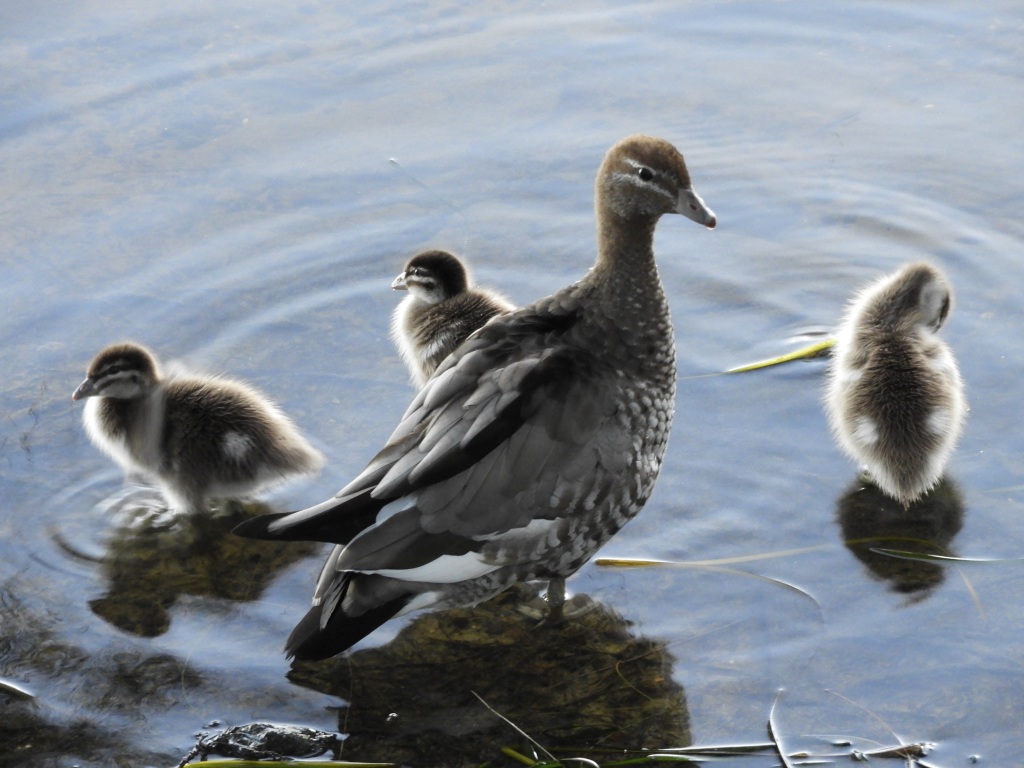
Common name: Australian Wood Duck
Scientific name: Chenonetta jubata
Approximate length of adult: 50 cm
Date spotted: 9 October 2020 (spring)
Location: Manly Dam Park, New South Wales, Australia: 33°46’58.5″S 151°15’18.6″E
Black Swans are back
It’s been a while since I’ve seen Black Swans on Manly Dam. Now they’re back, and four of them at that. Black Swans are native to New South Wales, Australia.
The call of a Black Swan is a soft hoot, a little like an apologetic cuckoo clock. You can hear it about 6 seconds into this video:
In the next video, the swans are caught in the converging melee of waterbirds when someone throws some scraps into the water. Again, the swans hoot about 6 seconds into the video:
This swan slides a bit of green weed through its beak, presumably to scrape off slime and small creatures as food:
Reflecting on reeds:
Common name: Black Swan
Scientific name: Cygnus atratus
Approximate length: 120 cm
Date spotted: 7 July 2018 (Winter)
Location: Manly Dam National Park, New South Wales, Australia: 33°46’58.3″S 151°15’18.7″E
Black Swans calling
Black swans are native to New South Wales, Australia. This morning I saw four of them swimming amongst the other water birds.
Two of them were calling to each other and raising their necks up and down in a stately dance. They make a slightly funny, bugling call, a bit like a child’s party tooter, as you can hear in this video:
Common name: Black Swan
Scientific name: Cygnus atratus
Approximate length: 120 cm
Date spotted: 27 December 2014
Season: Summer
Location: Manly Dam Reserve, New South Wales, Australia
Latitude/longitude: 33°46’58.4″S 151°15’18.6″E








